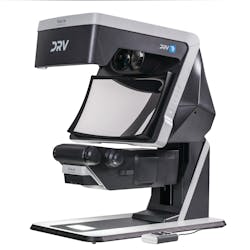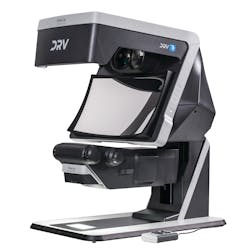Vision Engineering system inspects parts, molds offline
Vision Engineering Ltd. has launched two systems for inspecting and measuring plastic parts and molds offline, one of which features innovative 3-D viewing technology that provides multiple benefits for users.
“DRV-Z1 provides enhanced 3-D visualization and overcomes current problems with 3-D modeling and inspection systems,” said Mark Curtis, managing director of Vision Engineering. “By amalgamating our existing technologies, we’ve delivered an entirely new concept to our existing customer base, as well as opening up opportunities in fresh markets.”
The device uses patented technology to reflect slightly different angles of a specimen or sample to each eye of its operator. These separate images combine seamlessly, so the operator sees a crisp, high-resolution image of the sample, the company said.
The DRV-Z1 has a particular advantage for multi-site companies because multiple devices can be used at different locations to view the same image simultaneously.
The 2-D nature of traditional digital microscopes makes them difficult to use for tasks like deburring plastic parts because the images lack the depth inherent with a traditional stereomicroscope; the DRV-Z1’s 3-D technology overcomes that problem.
“The patented technology behind the DRV combines the best of both optical and digital technologies,” said Nili Walp, a Vision Engineering spokeswoman. “A sample viewed with the DRV does not display on a monitor (although a monitor can be used), but it ‘floats’ in front of the user in full HD 3-D. This is ideal for inspection and reworking tasks for plastic parts, molds or dies.”
The system also is appropriate for examining CAD drawings before the parts are printed or molded. As long as the CAD software has layers designed for two outputs — one for each eye — the DRV-Z1 can display the drawings in 3-D.
The magnification range of the microscope is from 6.1 times to 93 times. It can accommodate parts as large as 6 inches by 8 inches. The company says it is the first 3-D stereo digital viewer with zooming capabilities.
THREE-AXIS VIDEO MEASUREMENT
In May, Vision Engineering also introduced the LVC400, a fully automated three-axis CNC video measurement system. It is designed for measuring large components or multiple small components quickly, easily and accurately.
Applications within the plastics industry include measuring molds, dies and finished products.
The LVC400 includes a larger stage (15.7 inches by 11.8 inches by 7.9 inches) than comparably priced products, the company said. The stage’s movement is fully automated along all three axes, making component measurement faster.
The measurement system includes a high-resolution 5-megapixel USB3 camera, granite base for extra stability and a software package with comprehensive measurement functions, full reporting and data export, and fitting and thread measurement.
Bruce Geiselman, senior staff reporter
Contact:
Vision Engineering Inc. New Milford, Conn., 860-355-3776,
About the Author
Bruce Geiselman
Senior Staff Reporter Bruce Geiselman covers extrusion, blow molding, additive manufacturing, automation and end markets including automotive and packaging. He also writes features, including In Other Words and Problem Solved, for Plastics Machinery & Manufacturing, Plastics Recycling and The Journal of Blow Molding. He has extensive experience in daily and magazine journalism.

